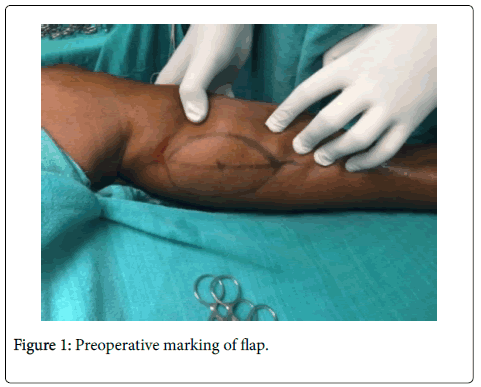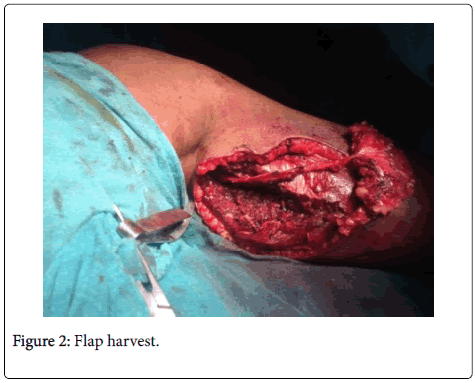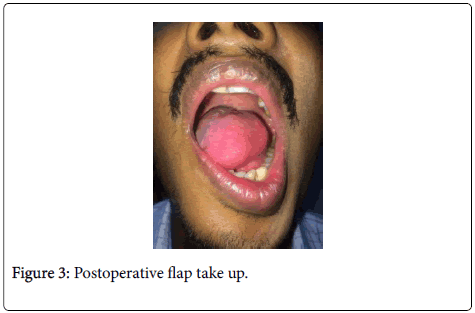Tounge Reconstruction with Medial Sural Artery Perforator Flap: A Case Report
Received: 30-May-2017 / Accepted Date: 09-Jun-2017 / Published Date: 13-Jun-2017 DOI: 10.4172/2476-2253.1000111
Abstract
There are numerous perforator flaps reported in the literature for head and neck reconstruction. We are presenting a case report of squamous cell carcinoma of Tongue which was operated by hemi glossectomy, modified radical neck dissection and reconstruction was done with medial sural artery perforator flap (MSAP). Preoperatively handheld Doppler was used to identify the perforator. The size of the flap was 5 × 6 cm, with 6 mm thick. The Medial Sural Artery Perforator Flap for tongue reconstruction is selected in our case as it is thin, pliable skin, reliable and sufficient vascular pedicle length.
Keywords: Medial sural artery perforator flap; Free flap; Head and neck reconstruction
7856Introduction
The medial sural artery perforator flap (MSAP) is fasciocutaneous flap and it was first described by Cavadas et al. in 2001 as a refinement of the gastrocnemius flap [1]. Kao et al. established its use in head and neck reconstruction on anatomic basis and its versatility of application [2]. It is a useful alternative to radial forearm flap providing hairless tissue and less donor site morbidity.
It is a revolutionary substitute to radial artery flap (RAF) and anterolateral thigh (ALT) flaps.. Perforator anatomy of MSAP flap is described by Hallock et al. [3]. Okamoto et al. reported about the anatomy of perforators present in MSAP flap [4]. Nugent and colleagues in 2015 reported that MSAP flap is surpassing to radial forearm flap for head and neck reconstruction [5].
Case Report
A 28 year male patient with squamous cell carcinoma of right lateral border of tongue (T2N1M0) was planned for modified radical neck dissection and hemiglossectomy with reconstruction by medial sural artery perforator flap. Handheld Doppler ultrasound 8 mega Hz was used to identify perforator [6,7]. The size of the flap was measured as per the defect size (Figure 1). Tourniquet was used by inflating it to 100 mm above systolic pressure of patient. Lateral incision was placed first to identify perforator. With meticulous dissection of perforator main trunk of medial sural vessel was identified (Figure 2). Tourniquet was released to check the blood flow on pedicle. The length of vascular pedicle was found to be 10 cm. Caliber of the medial sural artery and accompanying vein was found to be 0.8 mm and 1 mm respectively. End to end anastomosis was done with facial artery and internal jugular vein with 8-0 proline suture under magnification. Primary closure of the donor site done with drains in situ. Postoperatively flap was monitored for bleeding, color change and ischemia. A sterile needle was used to check for bleeding every four hourly for three days (Figure 3).
Discussion
There has been many micro vascular flap used for head and neck reconstruction. Aim of a surgeon is to achieve a good aesthetics, functional preservation with less morbidity to donor site. Kao et al. emphasized benefits of MSAP flap over RAF flap and reported that increased chances of donor site morbidity due to obliteration of radial artery [8-10]. Yoe et al. in 2014 done a prospective study of MSAP with computed tomographic angiography-aided design in tongue reconstruction and resulted most acceptable free flap for soft tissue defect [11]. Kekatpure et al., used ALT for oral reconstruction and delinated that it is bulkier flap, with hair growth in oral cavity, and dental rehabilitation is difficult with this flap [12].
We had used Handheld Doppler to locate the perforator which is an easy and simplified method for mapping. Doppler sonography can also be used for locating the perforators [11]. Shen et al. used endoscopy for locating perforator of MSAP flap.
In our case report we found two perforators during dissection. Wong et al. reported that sometimes the mapped perforator does not have an artery with them so one should confirm the pulsation of the perforator [13]. The vascular pedicle of MSAP we got was 10 cm which make it easy to anastomose with the recipient vessels over neck. The width our flap 5 × 6 cm, so primary closure was easily accomplished. Jason et al. used split thickness graft when donor site is wider than 5 cm [14]. Cavadas et al. reported by removal of the gastrocnemius muscle sometimes there is weakness in the leg and gait is disturbed (Table 1).
| COMPARISON | MSAP | RAFF | ALT |
|---|---|---|---|
| FLAP SIZE | SMALL TO MEDIUM | SMALL TO MEDIUM | MEDIUM TO LARGE |
| VASCULAR PEDICLE LENGTH | 8-12 CM | 10-15 CM | 8-12 CM |
| THICKNESS OF FLAP | 5-8 MM | 5-8 MM | MORE BULKY |
| ANATOMY OF FLAP | SAME | SAME | MORE VARIATION |
| DONOR SITE MORBIDITY | MILD | SCAR OVER FOREARM | MILD |
| PRIMARY CLOSURE OF DONOR SITE | 6 CM WIDTH | 3 CM | 8 CM |
| MEAN TIME OF FLAP HARVEST | 30-40 MIN | 30-40 MIN | 40-50 MIN |
Table 1: Vascular flap used for head and neck reconstruction.
Conclusion
We conclude that MSAP is a good replacement for tongue reconstruction as it is reliable, thin pliable, less technique sensitive for oral defect reconstruction.
References
- Cavadas PC, Sanz-Giménez-Rico JR, Gutierrez-de la Cámara A, Navarro-MonzonÃs A, Soler-Nomdedeu S, et al. (2001) The medial sural artery perforator free flap. Plast Reconstr Surg 108: 1609-15.
- Kao HK, Chang KP, Chen YA, Wei FC, Cheng MH (2010) Anatomical basis and versatile application of the free medial sural artery perforator flap for head and neck reconstruction. Plast Reconstr Surg 125: 1135-45.
- Hallock GG (2001) Anatomic basis of the gastrocnemius perforatorbased flap. Ann Plast Surg 47: 517-522.
- Okamoto H, Sekiya I, Mizutani J, Otsuka T (2007) Anatomical basis of the medial sural artery perforator flap in Asians. Scand J Plast Reconstr Surg Hand Surg 41: 125-129.
- Â Nugent M, Endersby S, Kennedy M, Burns A (2015) Early experience with the medial sural artery perforator flap as an alternative to the radial forearm flap for reconstruction in the head and neck. Br J Oral Maxillofac Surg 53: 461-463.
- Chen SL, Chen TM, Lee CH (2005) Free medial sural artery perforator flap resurfacing distal limb defects. J Trauma 8: 323-327.
- Umemoto Y, Adachi Y, Ebisawa K (2005) The sural artery perforator flap for coverage of defects of the knee and tibia. Scand J Plast Reconstr Surg Hand Surg 39: 209-212.
- McMahon JD, MacIver C, Smith M, Stathopoulos P, Wales C, et al. (2013) Postoperative complications after major head and neck surgery with free flap repair-prevalence, patterns, and determinants: a prospective cohort study. Br J Oral Maxillofac Surg 51: 689-695.
- Avery CM (2010) Review of the radial free flap: is it still evolving, or is it facing extinction? Part one: soft-tissue radial flap. Br J Oral Maxillofac Surg 48: 245-52.
- Kao HK, Chang KP, Wei FC, Cheng MH (2009) Comparison of the medial sural artery perforator flap with the radial forearm flap for head and neck reconstructions. Plast Reconstr Surg 124: 1125-1132.
- He Y, Jin SF, Zhang ZY, Feng SQ, Zhang CP, et al. (2014) A Prospective Study of Medial Sural Artery Perforator Flap with Computed Tomographic Angiography-Aided Design in Tongue Reconstruction. J Oral Maxillofac Surg 72: 2351-2365.
- Kekatpure VD, Trivedi NP, Shetkar G, Manjula BV, Mathan MA, et al. (2011) Single perforator based anterolateral thigh flap for reconstruction of large composite defects of oral cavity. Oral Oncol 47: 517-521.
- Shen XQ, Lv Y, Shen H, Lu H, Wu SC, et al. (2016) Endoscope-assisted medial sural artery perforator flap for head and neck reconstruction. J Plast Reconstr Aesthet Surg 69: 1059-1065.
- Wong JK, Deek N, Hsu CC, Chen HY, Lin CH, et al. (2017) Versatility and “flap efficiency†of pedicled perforator flaps in lower extremity reconstruction. J Plast Reconstr Aesthet Surg 70: 67-77.
Citation: Agrawal G, Gupta A, Chaudhary V (2017) Tounge Reconstruction with Medial Sural Artery Perforator Flap: A Case Report. J Cancer Diagn 2: 111. DOI: 10.4172/2476-2253.1000111
Copyright: © 2017 Agrawal G, et al. This is an open-access article distributed under the terms of the Creative Commons Attribution License, which permits unrestricted use, distribution, and reproduction in any medium, provided the original author and source are credited.
Select your language of interest to view the total content in your interested language
Share This Article
Recommended Journals
Open Access Journals
Article Tools
Article Usage
- Total views: 5988
- [From(publication date): 0-2017 - Jul 21, 2025]
- Breakdown by view type
- HTML page views: 5088
- PDF downloads: 900



